Crysis 2 – Review
by Dom
|
 On the front cover of Crysis 2, the review banner at the top reads: “The best looking game on console – IGN.” That’s a big claim to have printed on top of the game’s case – anyone casually passing by, looking at that bold statement, will have their expectations automatically heightened. It’s a dangerous marketing strategy – if it didn’t pay off, there would be a lot of annoyed consumers out there.
On the front cover of Crysis 2, the review banner at the top reads: “The best looking game on console – IGN.” That’s a big claim to have printed on top of the game’s case – anyone casually passing by, looking at that bold statement, will have their expectations automatically heightened. It’s a dangerous marketing strategy – if it didn’t pay off, there would be a lot of annoyed consumers out there.
Luckily for Crysis 2, this is definitely the best looking game on console.
Scratch that – this is the best looking game I’ve ever had the privilege of playing. I’m a massive fan of Final Fantasy XIII (I know, I know – I’m a philistine). I found the graphics in that game utterly mesmerizing. Crysis 2, however, wipes the floor with XIII; the level of realism is stunning, and the graphical textures are perfect. Even down to the smallest detail, this game delivers what you’d expect from the now almost-legendary Crysis – you shoot at the ceiling or at a wall in other shooters, and all that happens is a small bullet-shaped hole is laid over the base texture. In Crysis 2, shoot at some plaster and the plaster will crumble from the bullet, shoot at concrete and small chips will flick out. This may not seem like a massive deal, but when you have hundreds of munitions whizzing around on the screen and each of them makes their own mark on the environment, you really do get the feeling that your console is being pushed to its limit.
As sad as it may be to admit, we are nearing the end of this generation – we’ve already had five years of the PS3 and the 360. Rumours are rife about Microsoft unveiling their new console at E3 this year. The approach of this generation’s twilight is something that should be rejoiced, however, if developers and publishers are capable of pushing the 360 as hard as they are with Crysis. As the game boots up, one of the screens informs you that Crysis is ‘achieved with CryEngine 3’. ‘Achieved’ is the perfect word – the engine powering this game is, in a word, insane.
The game starts up very slowly – you’re a marine (named Alcatraz) who has been sent to New York to aid a nano-suit clad supersoldier, codenamed Prophet. (Crysis fans may recognize him from your squad in the first game). Seeing him again injects you with a rush of nostalgia and intrigue – why is he here? What’s gone wrong? Why has he killed himself? You’re introduced to Prophet after a short scene detailing the state of NYC and setting up the premise for your arrival. Granted, by this point, it all feels a bit hackneyed and a bit forced. The typical marine banter and the light-hearted references to killing make it all seem a little too CoD or Battlefield.
This is quickly reversed when things start kicking off, however. Your troop is ambushed by a Ceph (read: alien) raid, and your entire squad is wiped out. Prophet, in full nano-suit splendour, uncloaks and begins fighting back, planting tactical pot-shots here and there. He says a few enigmatic things about ‘destiny’ and ‘infection’ and then you black out. You wake up in the nano-suit once inhabited by Prophet, and from here there are two narratives that run concurrent with the actions you perform. The main story arc revolves around your hunt for a conspiracy theorist and scientist named Gould and, generally, trying to stop the alien invasion from the core. The second arc is slightly more cryptic – because Prophet inhabited the suit in the first game when he disappeared amongst the alien mountain structure, it can be assumed that his thought processes have been affected by the aliens in some way. You experience flashbacks from Prophet – his deep-level cognitive subroutines ingrain themselves into your psyche. This is a nice addition for new players to the franchise – it gives you a universal context without having to break the fourth wall or sacrifice any of the realism.
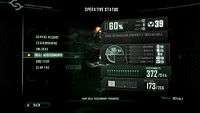 |
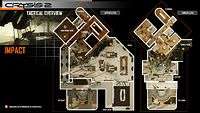 |
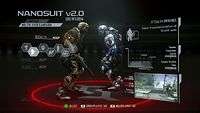 |
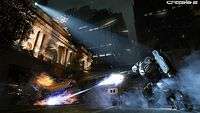 |
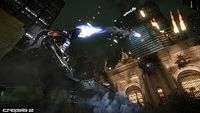 |
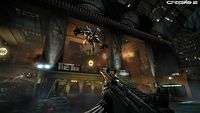 |
As the story progresses, you quickly become accustomed to Prophet’s suit, and the updates made since the first game are tangible. You have the cloak ability, naturally – the transparent-translucent graphical overlay is quite simply stunning. You walk around completely masked from the enemies, yet you can make out your own outline (just about). It’s a similar to the cloak feature in Halo: Reach, except better. The more you walk, the more the energy powering the suit depletes; crawl around and it will drain slower, use the suits insane agility and you will drain it almost instantly.
You can also quickly tap the right buffer (360) and activate armour mode – extremely useful if your stealth is compromised. It allows you to absorb heavy amounts of enemy fire without having too much bodily reaction – simply, you can stand and deliver return fire without too much interruption. The armour is also useful when you need to drop a long distance – coat yourself and the impact will merely damage you, rather than – say – breaking your legs.
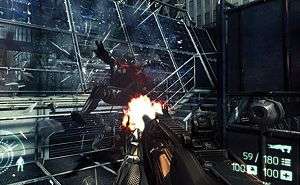 Pressing up on the D-pad will activate your visor (effectively, your in-depth HUD). The way the developers have removed this feature from being automatic is actually quite useful – it really makes you think about what you’re doing. The difference between this and the first game is that now, you really need to think about who you take out first, their proximity to you, their proximity to their teammates and their position in terms of the objective. If you wanted to, you could completely bypass all the enemies in an area and just dash on to the next section, taking cover to recharge your energy intermittently.
Pressing up on the D-pad will activate your visor (effectively, your in-depth HUD). The way the developers have removed this feature from being automatic is actually quite useful – it really makes you think about what you’re doing. The difference between this and the first game is that now, you really need to think about who you take out first, their proximity to you, their proximity to their teammates and their position in terms of the objective. If you wanted to, you could completely bypass all the enemies in an area and just dash on to the next section, taking cover to recharge your energy intermittently.
Something that will help you do this is the fascinating addition of nano-vision; a sort of hybrid mix of infrared and x-ray vision. Mixing this with your visor (and even stealth) can give you infinite options in terms of operation – you could slink around the enemies, highlighted with the nano-vision then tagged with your visor, you could find a spot in the middle of them, armour up and then just go mad, or you could stick to the method I’ve been using since I found a sniper (DSG-1) in the second level.
My favourite way of playing through the levels is to hold Back (again, 360) on the pad, bringing up the customization screen for your weapon. Here, a simple but effective interface is shown; press A numerous times to select your sights (choices range from Sniper to Assault, Ironsight to Reflex), press Y to select whether or not you want a Silencer, press B to select your miscellaneous attachment – this could be a light shotgun, extended clip or semi-automatic fire option. I choose Sniper scope and Silencer, move out with stealth, observe patrol patterns (which the aliens don’t adhere to, more on that later) and then begin picking the enemies off, one by one. Occasionally, you can sneak up behind someone, cloaked, and snap their neck with a nice little assassination animation.
If I get caught (which I often do), I armour up and go mental, raining lead everywhere with my Assault-modded machine gun and smacking anyone that gets too close. (It’s interesting to note that melee is incredibly weak unless you damage an enemy before trying to lay them out.) Although these two approaches sound quite formulaic, the dynamic level design ensures there is no experience repeated twice – you die and return to a checkpoint and things may play out completely differently, even if you act exactly the same. Of course, all this is rendered in beautiful 1080i graphics with the option of 3D – it’s beautiful.
The suit also allows you to mod different aspects of how you play the game – a quick tap of Back brings up your left hand, and each finger has four options coming off it, requiring purchase. You’re encouraged to kill enemy aliens to gather nano-catalysts – effectively upgrade currency. These can be used to enhance your stealth, mark enemy routes, allow you to run faster or to indicate immediate threats. The options are vast, again, and the perks you choose effect how you play the game.
 The biggest criticism I could level at the game would be the behaviour of the AI. The human enemies (Cell) tend to suffer less from confused patrols or glitching; maybe because their behaviour is more predictable. A lot of the time, when scoping out Ceph, you can notice that one of them is just spinning around in a circle or trapped between two objects (most of which are scripted to move anyway). Although this allows you to get a cheeky and cheap kill, it’s still a little off-putting, especially when the rest of the world Alcatraz inhabits is so physically realistic.
The biggest criticism I could level at the game would be the behaviour of the AI. The human enemies (Cell) tend to suffer less from confused patrols or glitching; maybe because their behaviour is more predictable. A lot of the time, when scoping out Ceph, you can notice that one of them is just spinning around in a circle or trapped between two objects (most of which are scripted to move anyway). Although this allows you to get a cheeky and cheap kill, it’s still a little off-putting, especially when the rest of the world Alcatraz inhabits is so physically realistic.
The human opponents tend to just freeze up when they glitch – they’re standing there, gun muzzle levelled in your face, and just… stop. All the intimidation and all the threat just dissipates and you’re left feeling a little deflated. Once I just walked up to a static enemy and hit him a few times. In the balls. It was gratifying.
The supporting friendly AI aren’t that intelligent, either – one mission near the start (Semper Fi or Die) has an achievement attributed to it involving the Marines on your team; it’s one of those ugly “keep everyone alive!” tasks. Now, usually, these sorts of missions aren’t that hard – just stick with the main body of the troop and shoot anything that moves. In Crysis, however, your marine friends (lead by uber-macho idiot Chino) decide to just wander off and run around, providing perfect cannon fodder for the waiting Ceph troops. Sometimes, they don’t even return fire. This is one of the most irritating aspects of the mission – it isn’t absolutely necessary to save them all, but doing so is made frustrating due to some buggy, broken AI.
There are occasional issues with weaponry, too – sometimes, the same enemy you blast away at for three full magazines will often die with a few rounds to the legs. The JAW missile launcher doesn’t quite have the impact on enemies you’d think, either; the explosion radius doesn’t quite correlate with damage inflicted. Again, this can be a little off-putting, especially when you’ve got some evil behemoth alien running at you, getting all up in your grill. You fire one of your JAWs right to their slobbering jaw, and all that happens is… nothing. Hmm.
 |
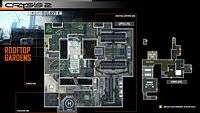 |
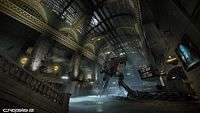 |
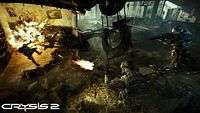 |
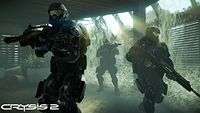 |
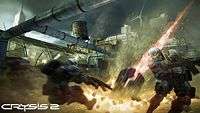 |
Aurally, the game is what you’d expect from something in this generation; soaring scores, racketing gunfire and disturbing half-mechanical, half-squelching alien squid noises. The environment is responsive and visceral – every small oil barrel or wooden slat you hit makes a unique sound, your proximity and angle affecting the way the sound reaches you. The pulse blasts and microwave charges resonate with ululating drones and distorted waves of sound, making every shot fired at you feel threatening.
The nano-suit itself succeeds in making you feel both powerful and vulnerable; all of the upgrades and perks you can select makes powering your way through enemies seem realistically easy (after all, you’re a super-soldier armed to the teeth with alien tech; your human opponents are corporation lapdogs with some flimsy armour). However, you know you’re not invincible – armour up and get shot at too much, you’ll inevitably get over-powered and overrun. This is why making use of the environment can come in handy; the levels are broken into what can only be described ‘blocks’ – you have one objective per block, and there are many ways of getting across the enemy filled gap. The visor helps you by recommending tactical standpoints – sometimes it will point out prime sniper positions, sometimes it will highlight supply crates and sometimes it will tell you prime targets to take out or secret areas to explore. These can all be tagged in the visor too, so going back into the shooting sights won’t distort your plans.
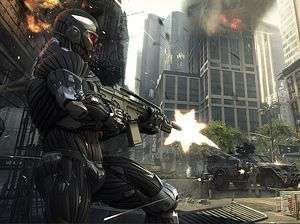 Going over the level, you’ll probably get through five or six ‘blocks’; each one will be riddled with enemies and different ways of dealing with them. My favourite thus far was in the first level – if you wait for long enough, a patrolling trooper will walk underneath a giant donut mounted on the top of a store. Using your suit’s absurd strength, you can knock it onto his head and kill him. This level of interactivity is pleasant – other levels let you climb entire mounds of trash that look like they’re just there to make the gaming universe a little more realistic. You can climb and snipe, find a hidden alcove and perform a few cheeky assassinations or just find a little bottleneck, armour up and litter your enemy’s faces with C4.
Going over the level, you’ll probably get through five or six ‘blocks’; each one will be riddled with enemies and different ways of dealing with them. My favourite thus far was in the first level – if you wait for long enough, a patrolling trooper will walk underneath a giant donut mounted on the top of a store. Using your suit’s absurd strength, you can knock it onto his head and kill him. This level of interactivity is pleasant – other levels let you climb entire mounds of trash that look like they’re just there to make the gaming universe a little more realistic. You can climb and snipe, find a hidden alcove and perform a few cheeky assassinations or just find a little bottleneck, armour up and litter your enemy’s faces with C4.
The levels themselves, although linear, are open to an extent – the biggest difference in structure between this and Crysis 1 is the way you are guided in a certain direction, rather than just left to reach an objective. The jungle setting of Crysis was pleasant and suited the game, but the nature of Crysis 2 – the imminent danger of the alien invasion and the brutal tactics of the Cell group – makes the stricter city setting of NYC seem much more apt. Having to go through the subway systems and broken storefronts whilst repelling Ceph just feels… right. Especially when you’re looking at one of the best renditions of New York you’re likely to see this gen.
The controls can sometimes inhibit you – when things get a little frantic in combat, Alcatraz will take about four hours to switch from his gun to a grenade or rocket launcher. Although the animations are smooth and accurate – and very realistic – from a mechanical standpoint, the lag just doesn’t seem to work; you end up dying whilst switching out to your Microwave Cannon, most of the time. Headshots aren’t always headshots, either – with the Sniper scope, you’re often fine, but switch to the Reflex or Laser sight and guaranteed headshots just tend to alert enemies instead, calling in their support and laying all of your carefully laid plans to waste.
As for longevity, the multiplayer has a lot to offer – fifty ranks to climb and a horde of little bonuses to unlock. The game can be played through in the standard four difficulty settings (basically easy to very hard) – giving you the chance to play through again and again and try different tactics each time. There are collectibles scattered through the levels, too, and scouring through all the items to find them can be pleasantly occupying – this is no Assassin’s Creed flag or feather collection; rather, it’s actually nice to look for things, and the rewards you get make it worth it. Even if there is no motivation for playing through the single-player campaign, it can still be a little therapeutic trying to figure out the most minimal way of taking out all the enemies.
Overall, the main thing I take away from this game is the graphics – it just looks so, so good. The bold claim from IGN stamped on the front makes sense when you play this game. There are a few bugs in the handling and the AI, but these don’t detract too much from the overall experience of the game – the stationary Cell and the spinning Ceph are just comic, really. The gameplay itself shows off just how powerful the CryEngine 3 is; the game is like a polished and perfect tech demo, showing off its beautiful biceps and toned tones, with a solid story and decent mechanics overlaid. The beauty in Crysis is not really in the gameplay (although it is good), it’s in what it achieves as a game – it’s a stellar example of what can be achieved by a decent production team with a decent engine.
Pros- Wide range of tactical options to utilize and experiment with.
- Potential to suit anyone and everyone’s style of play – fans of shooters may prefer stealth elements, fans of stealth may prefer shooter elements.
- Graphics. The most beautiful game I’ve seen running on a 360.
- Strong, driving story with interesting and 3-dimensional characters.
- Dodgy AI – enemies have a tendency to either freeze up or just completely ignore your presence.
- Non-consistent weaponry; damage effects and explosion radiuses seem to fluctuate sporadically.
Fantastic example of how graphics engines in games are evolving, interlaced with strong gameplay and story elements. Freedom to choose how you complete objectives opens up a lot of play time. Overall game let down by some glitches in the AI system.
Last five articles by Dom
- Defining Games, Part I: ‘Culture’
- Best of 2012 - 10 Games and Their Classic 8-Point Story Arcs
- 10 Games and Their Classic 8-Point Story Arcs
- Tekken Tag Tournament 2 - Review
- Tom Clancy’s Ghost Recon: Future Soldier - MP, Campaign, and Film Preview















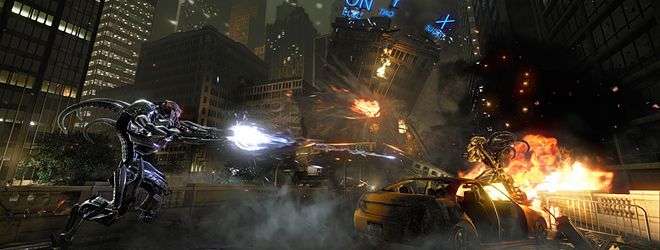
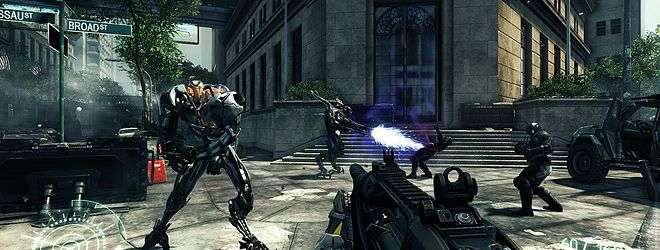
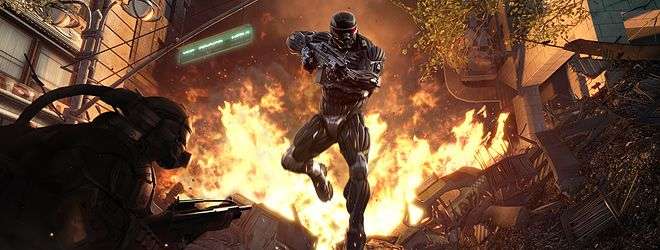





I dunno if I’m gonna get this. To me the “beta” seemed too Call of Duty, and I’ve never been interested in playing the first one!
Brilliant review though dood!
I want this game so bad it hurts. I was gutted to see it arrive, only for my schedule to be ridiculously full (or over-full if we can push the boundaries of physics for the sake of argument) as I’ve been waiting for a sequel since I completed the first game. I actually think that Crysis was the first game that A) made me want to upgrade my PC B) reached the state of “completed” within all my next gen era games and C) was the first game I used my controller on through the PC. I managed to spend the entire game as a sniper, right up until the last level when I went for a more close combat style. I WILL play this game one day, and I hope it fills me with as much excitement as the first did as I’d genuinely hate to be disappointed by it… even though nothing could take Crysis away from me. It looks like an awesome game, glitches and all!!
It is painful when such a fantastic looking game suffers from so many bugs. Like you said, AI is buggy as hell. Enemies getting stuck in boxes, ive seen some fly across the screen as if hit by invisible explosives. I love the weapons, the feel so much more realistic than games like COD.
I dono, I liked it. Story was ok, for an FPS it was a decent length for a change, it looks fucking stunning on the 360, can only imagine what they have done on the PC. Then its let down by the AI, the multiplayer is COD with cloaking. Would i recommend it. Probly not.
Wanted to wait until I’d finished the game before commenting, I gotta say I started off a bit indifferent about Crysis 2 and couldn’t decide if I liked it. Then the really cool stuff and the story started kicking in and I was hooked.
It was nice to be able to play a game that was like how FPS games used to be. To get punished for dying and having to sometimes start a fair bit back from where you were (not to far) it’s a good length too, none of this 4 hours and “that’s you lot” kind of FPS that seems to be far to popular of late. I loved that you can play it either stealthy or guns blazing too with different ways through different sections.
I think the team balancing with the multiplayer is a bit off (hopefully that’ll get better over time) and I get pissed off quick with people cloaking all the time. Also what’s with the two bullets and your dead thing? These guys are supposed to be bloody super soldiers! Could of done with being a bit less codblops and a bit more Halo in the health department but despite those things MP is still fun.
Bang on review Dom
I got the chance to preview the game in february with a couple of the other writers and I have to admit that I didn’t actually get as attached to this as I should; it had enough of a variation on the FPS for me to be interested in it and it looked pretty to boot. However, I gots too many games to play and I have all the FPS I’ll need for a while in Bulletstorm.
Still, great review Dom
Excellent review – the game looks stunning, but then that was pretty much to be expected. I saw the first game in action, though never took much of an interest – I don’t really do FPS – and thought that the jungle setting looked absolutely incredible. When I heard that this one had moved to an urban location I admit to sneering a little with boredom. That said, it still looks impressive – I can just imagine how the PC version will fly. Shame about all the glitches… expect a mega patch to eat your broadband any day now.